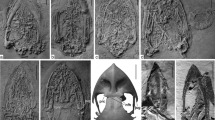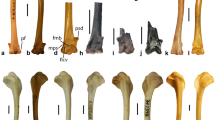Abstract
The Middle Eocene locality of Eocliff, Namibia, has yielded a rich vertebrate fauna, including mainly mammals, but also a few bird remains. A coracoid and a scapula are ascribed to a new genus and a new species of galliform in the extinct family Paraortygidae. This family was so far known only from the Late Eocene and Early Oligocene of the northern hemisphere. A distal part of tarsometatarsus is ascribed to a new genus and a new species of psittaciform. This tarsometatarsus shows a trochlea metatarsi IV which is characteristic of the crown group Psittaciformes, but, in other features, it is different from extant parrots and corresponds to a stem group Psittaciformes.
Zusammenfassung
Stammgruppenvertreter von galliformen und psittaciformen Vögeln (Aves, Galliformes, Paraortygidae und Psittaciformes, Familie incertae sedis) aus dem mittleren Eozän von Namibia
Aus der mitteleozänen Fossilfundstelle Eocliff in Namibia ist eine reichhaltige Vertebratenfauna überliefert, welche vor allem Säugetiere beinhaltet, daneben aber auch wenige Vogelreste. Ein Coracoid und eine Scapula werden einer neuen Gattung und Art der Galliformes zugeordnet, in der ausgestorbenen Familie Paraortygidae. Diese Familie war bisher nur aus dem späten Eozän und frühen Oligozän der Nordhemisphäre bekannt. Ein distaler Tarsometatarsus gehört zu einer neuen Gattung und Art der Psittaciformes. Der Bau der Trochlea metatarsi IV dieses Tarsometatarsus ist charakteristisch für Psittaciformes, aber in anderen Merkmalen unterscheidet sich der Knochen deutlich von heutigen Papageien und entspricht Stammgruppenvertretern der Psittaciformes.











Similar content being viewed by others
References
Alvarenga HMF (1995) Um Primitivo Membro da Ordem Galliformes (Aves) do Terciàrio Médio da Bacia de Taubaté, Estado de So Paulo, Brasil. An Acad bras Ciên 67:33–44
Baumel JJ, Witmer LM (1993) Osteologia. In: Baumel JJ, King AS, Breazile JE, Evans HE, Van den Berge JC (eds) Handbook of avian anatomy: nomina anatomica avium. Pub Nuttall Ornithol Club 23, Cambridge, pp 45–132
Bock WJ, Miller WDeW (1959) The scansorial foot of the woodpeckers, with comments on the evolution of perching and climbing feet in birds. Am Mus Novit 1931:1–45
Dyke GJ, Gulas BE (2002) The fossil Galliform Bird Paraortygoides from the Lower Eocene of the United Kingdom. Am Mus Novit 3360:1–14
Fischer K (1990) Der Hühnervogel Pirortyx major (Gaillard, 1939) aus dem marinen Mitteloligozän bei Leipzig (DDR). Mitt Zool Mus Berlin 66 (Suppl Ann Ornithol 14):133–136
Fischer K (2003) Weitere Vogelknochen von Diomedeoides (Diomedeoididae, Procellariiformes) und Paraortyx (Paraortygidae, Galliformes) aus dem Unteroligozän des Weißelsterbeckens bei Leipzig. Mauritiana 18:387–395
Hwang SH, Mayr G, Bolortsetsteg M (2010) The earliest record of a Galliform bird in Asia, from the Late Paleocene-Early Eocene of the Gobi Desert, Mongolia. J Vertebr Paleontol 30:1642–1644
Ksepka DT, Clarke JA (2012) A new stem parrot from the Green River Formation and the complex evolution of the grasping foot in Pan-Psittaciformes. J Vertebr Paleontol 32:395–406
Ksepka DT, Clarke JA, Grande L (2011) Stem parrots (Avec, Halcyornithidae) from the Green River Formation and a combined phylogeny of Pan-Psittaciformes. J Paleontol 85:835–852
Mayr G (1998) A new family of Eocene zygodactyl birds. Senckenberg Lethaea 78:199–209
Mayr G (2000a) A new basal galliform bird from the Middle Eocene of Messel (Hessen, Germany). Senckenberg Lethaea 80:45–57
Mayr G (2000b) New or previously unrecorded avian taxa from the Middle Eocene of Messel (Hessen, Germany). Mitt Mus Naturkd Berl Geowiss Reihe 3:207–219
Mayr G (2002) On the osteology and phylogenetic affinities of the Pseudasturidae—Lower Eocene representatives of parrots (Aves, Psittaciformes). Zool J Linn Soc 136:715–729
Mayr G (2005) The Paleogene fossil record of birds. Biol Rev 80:515–542
Mayr G (2006) New specimens of the early Eocene stem group galliform Paraortygoides (Gallinuloididae), with comments on the evolution of a crop in the stem lineage of Galliformes. J Ornithol 147:31–37
Mayr G (2007) New specimens of Eocene stem-group psittaciform birds may shed light on the affinities of the first named fossil bird, Halcyornis toliapicus KOENIG, 1825. N Jahrb Geol Palaeontol Abh 244:207–213
Mayr G (2009) Paleogene Fossil Birds. Springer, Berlin
Mayr G (2011) Well-preserved new skeleton of the Middle Eocene Messelastur substantiates sister group relationship between Messelasturidae and Halcyornithidae (Aves, ? Pan-Psittaciformes). J Syst Palaeontol 9:159–171
Mayr G, Clarke J (2003) The deep divergences of neornithine birds: a phylogenetic analysis of morphological characters. Cladistics 19:527–553
Mayr G, Daniels M (1998) Eocene parrots from Messel (Hessen, Germany) and the London Clay of Walton-on-the-Naze (Essex, England). Senckenberg Lethaea 78:157–177
Mayr G, Göhlich UB (2004) A new parrot from the Miocene of Germany with comments on the variation of the hypotarsus morphology in some Psittaciformes. Belg J Zool 134:47–54
Mayr G, Smith T (2013) Galliformes, Upupiformes, Trogoniformes, and other avian remains (?Phaethontiformes and ?Threskiornithidae) from the Rupelian stratotype in Belgium, with comments on the identity of “Anas” benedeni Sharpe, 1899. In: Göhlich UB, Kroh A (eds) Paleornithological Research 2013. Proceedings of the 8th international meeting of the society of avian paleontology and evolution, Vienna 2012, pp 23–35
Mayr G, Weidig I (2004) The Early Eocene bird Gallinuloides wyomingensis—a stem group representative of Galliformes. Acta Palaeontol Pol 49:211–217
Mayr G, Rana RS, Sahni A, Smith T (2007) Oldest fossil avian remains from the Indian subcontinental plate. Curr Sci 92:1266–1269
Mayr G, Rana RS, Rose KD, Sahni A, Kumar K, Singh L, Smith T (2010) Quercypsitta-like birds from the Early Eocene of India (Aves, ? Psittaciformes). J Vert Paleontol 30:467–478
Mayr G, Rana RS, Rose KD, Sahni A, Kumar K, Smith T (2013) New specimens of the Early Eocene Bird Vastanavis and the Interrelationships of Stem Group Psittaciformes. Paleontol J 47:1308–1314
Mourer-Chauviré C (1992a) The Galliformes (Aves) from the Phosphorites du Quercy (France): systematics and biostratigraphy. In: Campbell KE (ed) Papers in avian paleontology honoring Pierce Brodkorb. Nat Hist Mus Los Angeles Cty Sci Ser 36:67–95
Mourer-Chauviré C (1992b) Une nouvelle famille de Perroquets (Aves, Psittaciformes) dans l’Eocène supérieur des Phosphorites du Quercy. Geobios Mém Spéc 14:169–177
Mourer-Chauviré C (2000) A new species of Ameripodius (Aves: galliformes: Quercymegapodiidae) from the Lower Miocene of France. Palaeontology 43:481–493
Mourer-Chauviré C (2006) The avifauna of the Eocene and Oligocene Phosphorites du Quercy (France): an updated list. Strata Sér 1(13):135–149
Mourer-Chauviré C, Tabuce R, Mahboubi M, Adaci M, Bensalah M (2011a) A Phororhacoid bird from the Eocene of Africa. Naturwissenschaften 98:815–823
Mourer-Chauviré C, Pickford M, Senut B (2011b) The first Palaeogene galliform from Africa. J Ornithol 152:617–622
Mourer-Chauviré C, Tabuce R, Essid EM, Marivaux L, Khayati H, Vianey-Liaud M, Ben Haj Ali M (2013) A small galliform and a small cuculiform from the Eocene of Tunisia. In: Göhlich UB, Kroh A (eds) Paleornithological Research 2013. Proceedings of the 8th international meeting of the society of avian paleontology and evolution, Vienna 2012, pp 1–15
Pickford M, Senut B, Mocke H, Mourer-Chauviré C, Rage JC, Mein P (2014) Eocene aridity in southwestern Africa: timing of onset and biological consequences. Trans Roy Soc South Africa. doi:10.1080/0035919X.2014.933452
Rasmussen DT, Olson SL, Simons EL (1987) Fossil birds from the Oligocene Jebel Qatrani Formation, Fayum Province. Egypt. Smithson Contrib Paleobiol 62:1–20
Rasmussen DT, Simons EL, Hertel F, Judd A (2001) Hindlimb of a giant terrestrial bird from the Upper Eocene, Fayum. Egypt. Palaeontology 44:325–337
Schweizer M, Seehausen D, Güntert M, Hertwig ST (2010) The evolutionary diversification of parrots supports a taxon pulse model with multiple trans-oceanic dispersal events and local radiations. Mol Phylogenet Evol 54:984–994
Weigel RD (1963) Oligocene birds from Saskatchewan. Q J Fla Acad Sci 26:257–262
Acknowledgments
We thank the Geological Survey of Namibia (Gabi Schneider, Helke Mocke), the Namibian National Heritage Council (Alma Nankela), and Namdeb Diamond Corporation (Pty) Ltd (J. Jacob), for administrative and logistic aid and for authorising access to the Sperrgebiet. Thanks to Pierre Mein for comments concerning the ages of the Sperrgebiet Palaeogene localities and to Gerald Mayr for the translation of the abstract into German. Funding for the Namibia Palaeontology Expedition was kindly supplied by UMR 7207 CNRS, the University of Rennes (Project to F. Guillocheau) and Service de Coopération et d’Action Culturelle de l’Ambassade de France à Windhoek (Mr. Jean-Paul Martin).
Conflict of interest
The authors declare that they have no conflict of interest.
Author information
Authors and Affiliations
Corresponding author
Additional information
Communicated by F. Bairlein.
Rights and permissions
About this article
Cite this article
Mourer-Chauviré, C., Pickford, M. & Senut, B. Stem group galliform and stem group psittaciform birds (Aves, Galliformes, Paraortygidae, and Psittaciformes, family incertae sedis) from the Middle Eocene of Namibia. J Ornithol 156, 275–286 (2015). https://doi.org/10.1007/s10336-014-1124-y
Received:
Revised:
Accepted:
Published:
Issue Date:
DOI: https://doi.org/10.1007/s10336-014-1124-y




